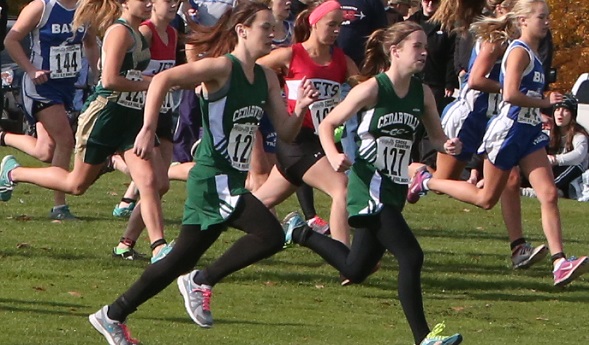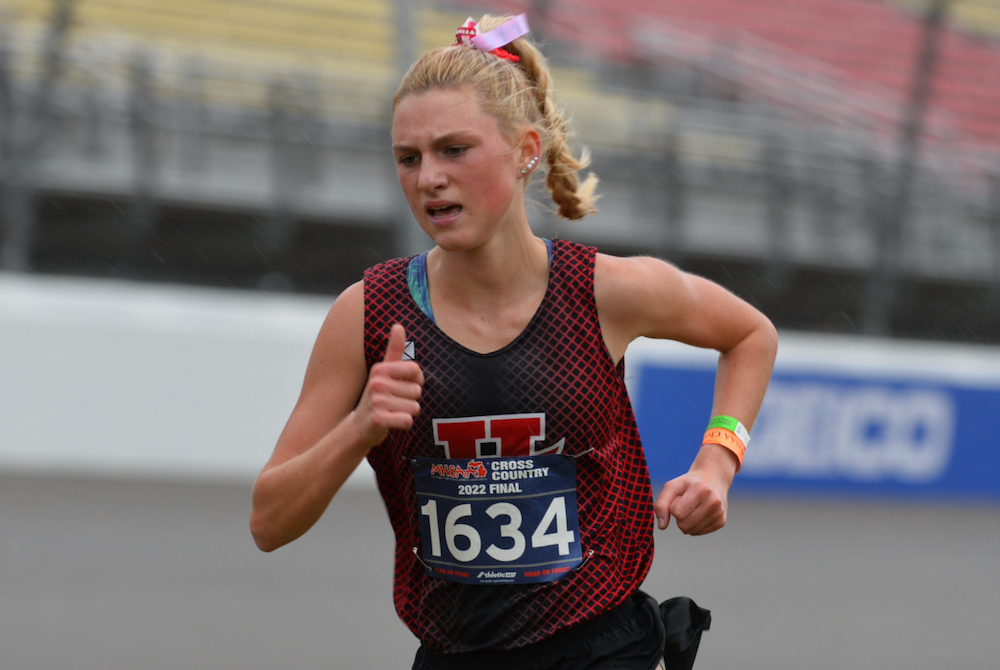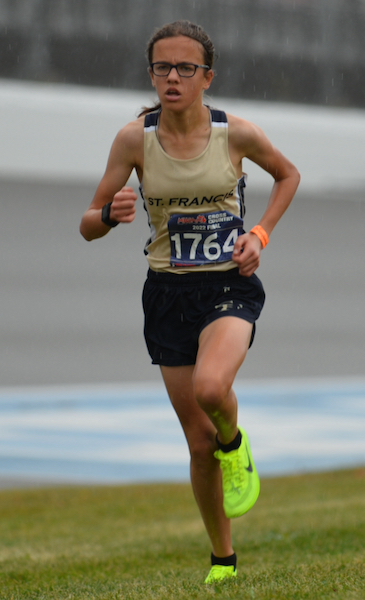
Preview: History in the Racing
October 17, 2014
By Geoff Kimmerly
Second Half editor
Gentz Homestead Golf Course in Harvey will host MHSAA Finals on Saturday that could showcase a few extremes in Upper Peninsula girls cross country.
In Division 1, Marquette is seeking its 29th MHSAA team title – owning the most by far of any school in either peninsula. Ishpeming in Division 2, meanwhile, is piling up accomplishments it hadn’t achieved in 35 years – and can add the crowning achievement with its first Finals win since 1980.
Somewhere in the middle, rivals Cedarville and St. Ignace should battle in Division 3 in what could be the most exciting race of the day.
Here's a look at some of the teams and individuals expected to cross the finish line first. Click for Saturday's race schedule and a list of all qualifiers.
DIVISION 1
Reigning champion: Marquette
2013 runner-up: Calumet
2014 top three: 1. Marquette, 2. Calumet, 3. Sault Ste. Marie.
Marquette has won more than twice as many Upper Peninsula Finals as any other school – Calumet happens to be second on that list with 11. The Redettes are heavy favorites again with four of the top nine individual finishers from last season back after the team scored 62 points fewer than the field. Junior Lindsey Rudden and sophomore Amber Huebner finished second and third, respectively, last season, while seniors Calla Martysz and Shayla Huebner came in eighth and ninth. But Calumet returns three of its top five, led by sixth-place Leah Kiilunen and 15th-place Corey Miller; both are juniors and Kiilunen finished second in 2012.
Individuals: Three more of last season’s top 15 will run this weekend. Escanaba senior Aimee Giese will race for her third top-10 finish after coming in fourth as a sophomore and 10th as a junior. Gladstone sophomore Leigha Woelfer was fourth last season in her first MHSAA Final, and Sault Ste. Marie senior Michaela Rushford improved from 17th in 2012 to 13th last season. Menominee senior Lilly Johnson also will try to finish on a fast note – she came in eighth as a freshman.
DIVISION 2
Reigning champion: Hancock
2013 runner-up: St. Ignace
2014 top three: 1. Ishpeming, 2. Ishpeming Westwood, 3. Hancock.
Ishpeming is favored to win its first MHSAA title since 1980 – but it’s been that kind of season for the Hematites, who also won their Mid-Peninsula Conference title for the first time since 1980. Ishpeming is shining with a lineup featuring five freshmen and two sophomores including Khora Swanson, who finished eighth a year ago. Westwood, second in the M-PC, is led by league individual champion Kathryn Etelamaki, a junior, and junior Anastasia Bjork, who finished ninth at last season’s Final. Hancock is keyed by two top-15 finishers from 2013 – 10th-place Kaylor Holmstrom, a senior, and junior Ashley Aho, who came in 14th.
Individuals: Iron River West Iron County senior Tori Harris-Hogaboom finished eighth as a freshman, sixth as a sophomore and seventh as a junior. She’s the second-highest returning finisher to this race, behind Norway junior Kyra Johnson, who finished fourth in 2013. Ironwood senior Katie Piispanen finished 14th as a sophomore.
DIVISION 3
Reigning champion: Munising
2013 runner-up: Cedarville
2014 top three: 1. Cedarville, 2. St. Ignace, 3. Dollar Bay.
Cedarville was champion in 2011 and runner-up last season and 2010, and returns a pair of top sophomores that lead a team with six underclassmen total. Emma Bohn is back after finishing third, and Leila Schlosser came in 12th as a freshman in 2013. But St. Ignace should provide an incredible challenge with its top five finishers back from last season’s runner-up in Division 2. Junior Lily Calcaterra was the individual runner-up in that race and in Division 3 as a sophomore, and sophomore Rosy Shimkovitz and junior Katie O’Rourke finished 11th and 12th, respectively, last season.
Individuals: Rudyard senior Kaylee Hoolsema will attempt to repeat as champion after winning last season's race by 44 seconds. Dollar Bay's Cami Daavettila was eighth last season as a freshman, and Chassell juniors Julia Pietila and Sam Shitaye finished 13th and 15th, respectively.
PHOTO: Cedarville's Emma Bohn (127) finished third in the Division 3 race a year ago and leads this season's favorite. (Photo courtesy of RunMichigan.com/Paul Gerard.)

Jazwinski Brings Hart Individual Title as St. Francis Moves to Front of Team Pack
November 5, 2022
BROOKLYN – Cross country races can be won between the ears before runners ever step foot onto the course.
Attitudes were tested as rain began to descend on Michigan International Speedway and the wind picked up just before the start of the MHSAA Lower Peninsula Division 3 girls race late Saturday morning.
Hart sophomore Jessica Jazwinski was loving life as she prepared to race.
“As a distance runner, I really try to love the wind,” she said. “Distance running and cross country is just a tough sport. The wind just adds to it — and the rain, too. It’s super fun.
“I was just thinking these conditions are just gonna feed my great race. This is real cross country. Yeah!”
Jazwinski overcame the elements to run the fifth-fastest Division 3 time ever, winning with a time of 17:36.70. She has two of the top-five times in Division 3 Finals history, having run 17:31.4 to place third last year.
“Today my race plan was just to go out hard and try to hold on to my pace,” she said. “I feel like I tried to race a lot like Steve Prefontaine, just go out and hold on.”
 Lansing Catholic senior Hannah Pricco was second in 18:17.59, Onsted sophomore Emmry Ross was third in 18:20.96 and Hart junior Alyson Ens was fourth in 18:28.52.
Lansing Catholic senior Hannah Pricco was second in 18:17.59, Onsted sophomore Emmry Ross was third in 18:20.96 and Hart junior Alyson Ens was fourth in 18:28.52.
“I love having great teammates to work with and encourage each other,” Jazwinski said. “We really try to encourage each other so much throughout the races. Throughout this year, some races she’s been a minute behind me, some races she’s been five seconds. I don’t want her to ever beat me, so that pushes me so much. I know she’s trying to race me and get up there with me.”
The only downer for Hart was having its string of Division 3 championships end at five with a fourth-place finish. Hart had two runners in the top four, but its No. 3 runner was 68th.
“I would totally trade my individual title for a team title,” Jazwinski said.
Traverse City St. Francis emerged from a close battle to win its first title since 2016 with 134 points. Pewamo-Westphalia was second with 142 and Lansing Catholic third with 165.
Sophomore Betsy Skendzel led St. Francis, placing seventh in 18:48.33. Completing the team score were senior Sophia Rhein in 26th (19:43.27), sophomore Grace Slocum in 33rd (20:07.95), junior Rylee Duffing in 60th (20:44.82) and junior Margot Hagerty in 63rd (20:45.78).
Lansing Catholic had three place in the top 10, but didn’t get another finisher until 103rd.
PHOTOS (Top) Hart’s Jessica Jazwinski pushes toward the finish during Saturday’s LPD3 Final. (Middle) Traverse City St. Francis’ Betsy Skendzel leads the way for the eventual team champion. (Click for more from Dave McCauley/RunMichigan.com.)

